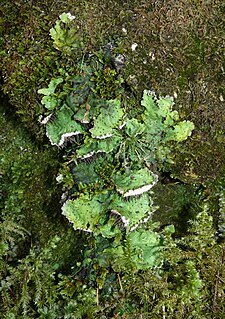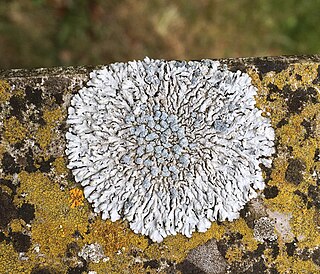
Peltigera is a genus of approximately 100 species of foliose lichens in the family Peltigeraceae. Commonly known as the dog or pelt lichens, species of Peltigera are often terricolous, but can also occur on moss, trees, rocks, and many other substrates in many parts of the world.

Peltigera scabrosa is a lichen native to North America, primarily Canada. Its common name is scabby pelt.

Erioderma is a genus of lichen-forming fungi in the family Pannariaceae. They are commonly called mouse ears or felt lichens, and are small, pale brown to olive-brown foliose cyanolichens with a fuzzy upper surface that have the cyanobacteria Scytonema as their photobiont. Most species are found in the tropics of Central and South America, although three species are found in coastal regions of North America where they generally grow on mossy branches in humid sites. All North American species are rare. Species of Erioderma can resemble Pannaria, Leioderma, or small Peltigera, but their fuzzy upper surface and lack of veins on their lower surface distinguishes them from these lichens.

Nephroma is a genus of medium to large foliose lichens. The genus has a widespread distribution. They are sometimes called kidney lichens, named after the characteristic kidney-shaped apothecia that they produce on the lower surface of their lobe tips, which often curl upwards and thus are visible from above. Sterile specimens that do not have apothecia can look somewhat like Melanelia, Peltigera, Platismatia, or Asahinea. Most species grow either on mossy ground or rocks, or on trees.

Physcia caesia, known colloquially as blue-gray rosette lichen and powder-back lichen, is a species of foliose lichenized fungus. First described by Georg Franz Hoffmann in 1784, it is common across much of Europe, North America and New Zealand, and more patchily distributed in South America, Asia, Australia and Antarctica. There are 2 subspecies: P. c. caesia and P. c. ventosa, as well as a number of distinct forms and varieties. Molecular studies suggest that the species as currently defined may be polyphyletic. It is typically pale gray shading to darker gray in the center, and grows in a small rosette, usually some 2–3 cm (0.79–1.18 in) across at maturity. It only rarely has apothecia, instead reproducing most often vegetatively via soredia, which are piled in round blue-gray mounds across the thallus's upper surface. It grows most often on rock—principally calcareous, but also basaltic and siliceous—and also occurs on bone, bark and soil. It is nitrophilic and is particularly common on substrates where birds perch.

Lecanora polytropa, commonly known as the granite-speck rim lichen, is a species of saxicolous lichen in the family Parmeliaceae. A small, inconspicuous species that grows in the cracks of rock surfaces, it has a cosmopolitan distribution and has been recorded on all continents, including Antarctica.

Parmotrema arnoldii, commonly known as the powdered ruffle lichen, is a widely distributed species of lichen in the family Parmeliaceae. It has been recorded from Africa, Asia, Europe, Oceania, Macaronesia, and North and South America.

Protoparmelia badia is a species of crustose lichen in the family Parmeliaceae. It is a widely distributed, common species that grows on rocks.
Peltigera vainioi is a species of lichen in the family Peltigeraceae. It is found in high-elevation locations in South America. It is a somewhat unusual species in its genus, characterized by a single holdfast that attaches to its substrate, and pores in its cortex.

Peltigera canina, commonly known as the dog lichen, is a widely distributed species of foliose lichen in the family Peltigeraceae. It was originally described by Carl Linnaeus in his 1753 work Species Plantarum. German botanist Carl Ludwig Willdenow transferred it to the genus Peltigera in 1787. This species is currently undergoing research as it is likely multiple species under one united name.

Peltigera lepidophora, commonly known as the fan lichen, is a species of foliose lichen in the family Peltigeraceae. It was first described by Carl Linnaeus in his 1753 work Species Plantarum as Lichen venosus. German botanist Georg Franz Hoffmann transferred it to the genus Peltigera in 1789. P. venosa can be found in temperate and boreal regions of North America, Europe, and Asia, while occasionally being found in drier climates such as mountainous Arizona.

Peltigera degenii is a species of foliose lichen in the family Peltigeraceae. It was first formally described in 1927 by Hungarian lichenologist Vilmos Kőfaragó-Gyelnik. The Chinese species Peltigera neodegenii is similar in appearance. Peltigera degenii has a shiny upper surface. In North America, it is a relatively rare forest species.

Umbilicaria deusta, commonly known as peppered rock tripe, is a widely distributed species of saxicolous lichen in the family Umbilicariaceae. It was first described by Carl Linnaeus in his 1753 work Species Plantarum as Lichen polyphyllus. German botanist Johann Christian Gottlob Baumgarten transferred it to the genus Umbilicaria in 1790. The lichen has a dark brown to nearly black thallus that typically measures 1–5 cm (0.4–2.0 in) in diameter. The upper surface is covered with tiny black dots that are granular isidia; the lower surface is the same colour as the upper surface, and is either smooth or covereds with dimples. It grows on exposed boulders and rocky outcrops.

Punctelia bolliana, the eastern speckled shield lichen, is a species of foliose lichen in the family Parmeliaceae. It is found in North America, with a distribution extending from the Canadian province of Ontario south to the central and northeastern United States and Mexico. It grows on the bark of both deciduous trees and coniferous trees. The combination of characteristics that distinguishes this species from others in genus Punctelia are the absence of the vegetative propagules isidia and soralia, a pale brown lower thallus surface, and the presence of the secondary chemical protolichesterinic acid in the medulla.

Peltigera neckeri is a foliose lichen in the family Peltigeraceae. It is commonly called black saddle pelt. It is distinguished by its unique tubular apothecia, which resemble black saddles or painted finger nails.

Peltigera rufescens, commonly known as the field dog lichen, is a species of terricolous (ground-dwelling), foliose lichen in the family Peltigeraceae. The common and widespread species has a cosmopolitan distribution.
Peltigera wulingensis is a species of terricolous (ground-dwelling), foliose lichen in the family Peltigeraceae. It is found in northern China.

Umbilicaria virginis, commonly known as the blushing rock tripe, is a species of saxicolous (rock-dwelling) umbilicate lichen in the family Umbilicariaceae. It occurs in polar and alpine regions.

Ochrolechia upsaliensis is a species of crustose lichen in the family Ochrolechiaceae. Found in the Northern Hemisphere, it is commonly known as the tundra saucer lichen.

Solorina crocea, commonly known as the orange chocolate chip lichen, is a species of terricolous (ground-dwelling) and foliose (leafy) lichen in the family Peltigeraceae. The lichen, which was first formally described by Carl Linnaeus in 1753, has an arctic–alpine and circumpolar distribution and occurs in Asia, Europe, North America, and New Zealand. It generally grows on the bare ground in sandy soils, often in moist soil near snow patches or seepage areas. Although several forms and varieties of the lichen have been proposed in its history, these are not considered to have any independent taxonomic significance.


















